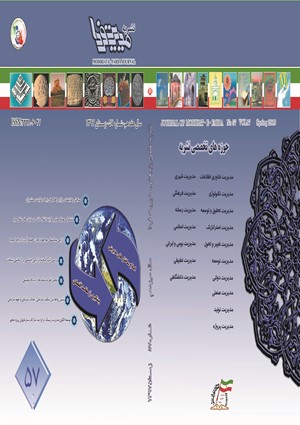بررسی وضعیت موجود سطح مدیریت دانش دانشگاه پیام نور استان خوزستان
محورهای موضوعی : مدیریت دانش
عباس عباسپور
1
,
فرهاد کیانفر
2
![]() ,
محمد رضا نیلی احمد آبادی
3
,
حمید رحیمیان
4
,
عصمت مومنی
5
,
محمد رضا نیلی احمد آبادی
3
,
حمید رحیمیان
4
,
عصمت مومنی
5
1 - دانشگاه علامه طباطبایی
2 - روانشناسی و علوم تربیتی
3 - دانشگاه علامه طباطبایی
4 - دانشگاه علامه طباطبایی
5 - دانشگاه علامه طباطبایی
کلید واژه: مدیریت دانش مدل نوناکا و تاکه اوچی دانشگاه پیام نور خوزستان,
چکیده مقاله :
پژوهش حاضر با هدف بررسی وضعیت موجود سطح مدیریت دانش دانشگاه پیام نور استان خوزستان به روش توصیفی و از نوع مطالعات پیمایشی انجام شده است. جامعه آماری این پژوهش، کلیه اعضای هیات علمی دانشگاه پیام نور استان خوزستان به تعداد 171 نفر می باشند که همین تعداد نیز به عنوان نمونه آماری انتخاب شند. ابزار گردآوری داده ها، پرسشنامه محقق ساخته مدیریت دانش براساس مدل نوناکا و تاکه اوچی بود که روایی آن با استفاده از نظرات استاتید راهنما و مشاور تایید شد و پایایی آن نیز به روش آلفای کرانباخ به دست آمد که عدد به دست آمده 88/0 نشان از همبستگی درونی گویه های پرسشنامه بود. جهت تجزیه و تحلیل داده ها هم از روشهای آمار توصیفی مانند میانگین و انحراف معیار، وهم از روشهای آمار استنباطی، تی تک نمونه جهت بررسی وضعیت موجود سطوح مدیریت دانش استفاده شد. یافته ها نشان داد که در دانشگاه پیام نور استان خوزستان مدیریت دانش در ابعاد دانش پنهان فردی، فرایند برون سازی دانش، فرایند ترکیب، فرایند درون سازی، دانش پنهان جمعی از سطح اجتماعی سازی دانش، فرایند اجتماعی سازی دانش در وضعیت بالاتر از حد متوسط قرار دارند و سطح معناداری به دست آمده نیز نشان از تایید فرضیه های محقق مبنی بر وجود سطوح مدیریت دانش اشاره شده در دانشگاه پیام نور خوزستان می باشد که در نهایت تنها بعد دانش آشکار فردی دانشگاه پایین ترازمتوسط میانگین بود. همچنین دانش آشکار جمعی که از مجموعه فرایند ترکیب دانش می باشد نیز در وضعیت نسبتاً ضعیفی قرار دارد. نتایج این پژوهش نشان داد که از مجموع چهار سطح دانش مدل مذکور در دانشگاه مورد مطالعه با توجه به امتیازات کسب شده، سه سطح تبدیل دانش درونی و بیرونی و اجتماعی در وضعیت مطلوبی قرار دارند و تنها سطح دانش ترکیب است که در وضعیت نسبتاً ضعیفی قرار دارد و نیاز به توجه بیشتری به این سطح از دانش است بدین معنی که این دانشگاه در این سطح موفق عمل نکرده است و در پایان پیشنهادهای لازم ارائه شده است.
The present study was conducted with the aim of investigating the present status of the knowledge management level of Payame Noor University of Khuzestan province by descriptive and survey research. The statistical population of this study is all faculty members of Payame Noor University of Khuzestan who have 171 people. The same number is selected as a statistical sample. The data gathering tool was a researcher-made knowledge management questionnaire based on the Unica and Tike Uchihi model, whose validity was confirmed using statutory guidance and counselor's opinion, and its reliability was obtained by Cronbach's alpha, with a figure of 0.88 the internal consistency of the questionnaires was internal. To analyze the data, descriptive statistics such as mean and standard deviation, as well as inferential statistics methods, were used to examine the existing status of knowledge management levels. The findings of this study showed that Knowledge Management in the field of hidden knowledge, knowledge outsourcing process, synthesis process, internalization process, collective hidden knowledge of knowledge socialization level, Knowledge socialization process in higher than average condition in Payame Noor University of Khuzestan province. And the significance level obtained also confirms the researcher's hypotheses about the existence of knowledge management levels mentioned in Payame Noor University of Khuzestan. Ultimately, the only obvious individual's knowledge of the university was below average. Also, the apparent collective knowledge that comes from the collection of knowledge synthesis process is also relatively weak. The results of this study showed that of the four levels of knowledge of the model in the studied university, according to the obtained points, the three levels of internal and external knowledge transfer are in a desirable situation, and only the level of knowledge of the combination is in a relatively weak position It needs to pay more attention to this level of knowledge, meaning that the university has not performed at this level and offers the necessary proposals at the end.
